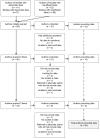Impact of contacting study authors to obtain additional data for systematic reviews: diagnostic accuracy studies for hepatic fibrosis
- PMID: 25239493
- PMCID: PMC4185334
- DOI: 10.1186/2046-4053-3-107
Impact of contacting study authors to obtain additional data for systematic reviews: diagnostic accuracy studies for hepatic fibrosis
Abstract
Background: Seventeen of 172 included studies in a recent systematic review of blood tests for hepatic fibrosis or cirrhosis reported diagnostic accuracy results discordant from 2 × 2 tables, and 60 studies reported inadequate data to construct 2 × 2 tables. This study explores the yield of contacting authors of diagnostic accuracy studies and impact on the systematic review findings.
Methods: Sixty-six corresponding authors were sent letters requesting additional information or clarification of data from 77 studies. Data received from the authors were synthesized with data included in the previous review, and diagnostic accuracy sensitivities, specificities, and positive and likelihood ratios were recalculated.
Results: Of the 66 authors, 68% were successfully contacted and 42% provided additional data for 29 out of 77 studies (38%). All authors who provided data at all did so by the third emailed request (ten authors provided data after one request). Authors of more recent studies were more likely to be located and provide data compared to authors of older studies. The effects of requests for additional data on the conclusions regarding the utility of blood tests to identify patients with clinically significant fibrosis or cirrhosis were generally small for ten out of 12 tests. Additional data resulted in reclassification (using median likelihood ratio estimates) from less useful to moderately useful or vice versa for the remaining two blood tests and enabled the calculation of an estimate for a third blood test for which previously the data had been insufficient to do so. We did not identify a clear pattern for the directional impact of additional data on estimates of diagnostic accuracy.
Conclusions: We successfully contacted and received results from 42% of authors who provided data for 38% of included studies. Contacting authors of studies evaluating the diagnostic accuracy of serum biomarkers for hepatic fibrosis and cirrhosis in hepatitis C patients impacted conclusions regarding diagnostic utility for two blood tests and enabled the calculation of an estimate for a third blood test. Despite relatively extensive efforts, we were unable to obtain data to resolve discrepancies or complete 2 × 2 tables for 62% of studies.
Figures
References
-
- Gibson CA, Bailey BW, Carper MJ, Lecheminant JD, Kirk EP, Huang G, Dubose KD, Donnelly JE. Author contacts for retrieval of data for a meta-analysis on exercise and diet restriction. Int J Technol Assess Health Care. 2006;22:267–270. - PubMed
-
- Higgins JPT, Green S. Cochrane Handbook for Systematic Reviews of Interventions Version 5.1.0. The Cochrane Collaboration: [Updated March 2011]; 2011. [ http://www.cochrane-handbook.org]
-
- Balshem H, Stevens A, Ansari M, Norris S, Kansagara D, Shamliyan T, Chou R, Chung M, Moher D, Dickersin K. AHRQ and the Effective Health Care Program. In Methods Guide for Effectiveness and Comparative Effectiveness Reviews. Rockville: Agency for Healthcare Research and Quality: AHRQ Publication No 10(14)-EHC063-EF; 2013. Finding grey literature evidence and assessing for outcome and analysis reporting biases when comparing medical interventions; pp. 19–20. - PubMed
Publication types
MeSH terms
Substances
Grants and funding
LinkOut - more resources
Full Text Sources
Other Literature Sources
Medical


